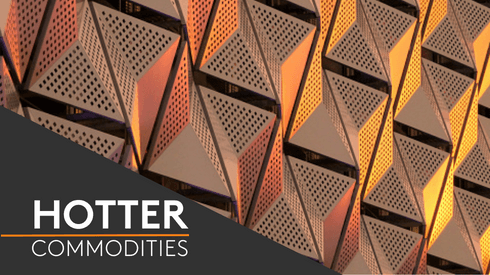Lead and zinc prices are off the most, down 0.9% and 0.8%, respectively, while nickel, aluminium and copper are off an average of 0.2% with three-month copper prices at $5,825 per tonne. Tin is the lone metal in positive territory this morning – prices are up 0.1% at $19,750 per tonne. This follows a mixed performance on Friday when lead and zinc prices closed firmer, while the rest closed lower, led by a 1.1% drop in tin prices. Volume this morning has been average with 5,375 lots traded.
Gold, platinum and silver prices continued to sell-off while palladium prices are firmer. Silver leads on the downside with a 1% drop to $15.41 per oz, gold prices are down 0.5% at $1,207.08 per oz and platinum prices are off 0.2%, while palladium is up 0.1%. This follows a drop of 3.1%in silver price on Friday, a 1% drop in gold prices and a 0.6% fall in platinum prices, while palladium prices climbed 0.5%.
On the Shanghai Futures Exchange (SHFE), lead and zinc prices are higher with gains of 0.4% and 0.5%, respectively, while nickel prices lead on the downside with 1% drop, tin prices are down 0.5%, aluminium prices are off 0.2% and copper prices are little changed at 46,880 yuan ($6,891) per tonne. Spot copper prices in Changjiang are up 0.2% at 46,710-46,910 yuan per tonne and the LME/Shanghai copper arb ratio has firmed to 8.05.
September iron ore prices on the Dalian Commodity Exchange are up 1.4% at 479 yuan per tonne, while on the SHFE, steel rebar prices are up 1.4%, silver prices are down 3.1% and gold prices are off 0.9%
In international markets, spot Brent crude oil prices are up 0.1% at $46.84 per barrel and the yield on the US ten-year treasuries remains at 2.38%, the German ten-year bund is unchanged at 0.56%.
Good US employment data on Friday helped steady equities with the Euro Stoxx 50 closing all but flat, while the Dow closed up 0.4% at 21,414.34. Asia this morning is also firmer, with the Nikkei and Hang Seng both up 0.8%, the ASX 200 is up 0.4%, the CSI 300 is up 0.2% and the Kospi is up 0.1%.
The dollar index, at 96.05 is slightly firmer, it looks as though the dollar is trying to form a base having falling from 103.80 in early January – this despite the interest rate rises and a generally hawkish US Federal Reserve (Fed). The euro is at 1.1400, it is holding just below recent highs of 1.1445, sterling is weaker at 1.2899, the yen is weak at 114.20 and the Australian dollar at 0.7604 appears to be consolidating.
Economic data out so far this morning shows a fairly steady to slightly better situation with Japan’s bank lending rising 3.3%, from 3.2%, core machine orders were worse than expected but it is a volatile data series, Japan’s current account showed imports rose 15.8% and exports climbed 12.9% and economic watchers sentiment climbed to 50 from 48.6. China’s consumer price index and producer price index came in unchanged at 1.5% and 5.5%, respectively, and Germany’s trade balance showed exports rose 0.8% and imports grew 1.2%. Data out later includes EU Sentix investor confidence, US labour market conditions index and consumer credit.
The base metals are looking weaker this morning with aluminium, lead and zinc consolidating in high ground, while the prices of the other metals seem to be drifting either as they consolidate, or as part of a correction. We now wait to see if the prices are indeed consolidating, or whether the earlier rallies are now over and prices are heading lower again. With the summer slowdown upon us, further weakness could follow, although given a less than firm second quarter for metals prices, it may be that consumers are still running hand to mouth and therefore there will be steady demand for metals through the summer.
Gold, silver and platinum prices are trending lower with some important support levels broken – this as bond yields rise and investors are keeping calm over the developments in North Korea. The firmer monetary policy rhetoric from the Fed, the European Central Bank and even the Bank of England, have raised the opportunity cost of holding precious metals and investors are voting with their feet as this unfolds. While this happens, we would keep an eye on geopolitical developments, we expect these to rise before too long, but weaker precious metals prices should therefore lead to even cheaper havens should the need arise.
Metal Bulletin publishes live futures reports throughout the day, covering major metals exchanges news and prices.





